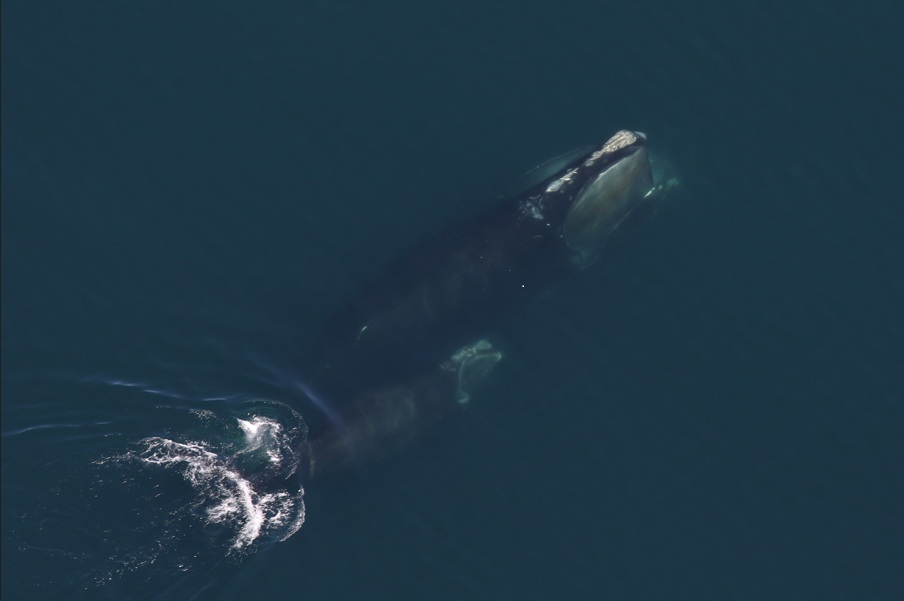Top Stories
North Atlantic Right Whale Population Rises to 384; Hope Grows

UPDATE: The critically endangered North Atlantic right whale population has seen a glimmer of hope, increasing to 384 individuals in the latest estimate for 2024, marking a 2.1% rise from 376 in 2023. Researchers from the New England Aquarium and NOAA have just announced this positive news, igniting cautious optimism among conservationists.
“This is a significant moment for us as we share encouraging data about this critically endangered species,” stated Heather Pettis, leader of the right whale research program at the Aquarium’s Anderson Cabot Center. She emphasized that this year has brought no detected mortalities and fewer injuries compared to previous years, which fuels hope for the future of North Atlantic right whales.
Despite this positive trend, experts caution that ongoing protective measures are essential for the species’ continued growth. “With small population increases year to year, we still need strong protective measures for continued growth,” Pettis added, underscoring that conservation efforts must remain a priority.
The past year was particularly devastating, with five right whale deaths and 16 entanglements recorded in 2024. Fortunately, 2025 has begun on a more positive note, with scientists reporting no deaths so far, alongside just one new entanglement injury without attached fishing gear and one vessel strike.
However, the challenges remain daunting. Right whales from previous years still struggle with entanglements, and scientists anticipate that more entanglements may be identified later this year, as 50% of last year’s incidents were detected in the latter half of the year.
“Detecting entanglements is challenging as it requires two things to align: people to be looking and whales to be present in those times and locations where they’re looking,” explained Philip Hamilton, a senior scientist at the Aquarium. He highlighted the critical need for continuous collaboration among state, federal, and private entities to monitor right whales effectively.
One particularly troubling case involves Catalog #5110, a right whale spotted entangled in December far from shore. This whale was seen again in April in Cape Cod Bay, still encumbered by fishing gear. Although efforts from the Center for Coastal Studies’ Marine Animal Entanglement Response team managed to remove some gear, the whale is still left with life-threatening entanglements.
“This case is a sad reminder of the persistent challenges to the survival and recovery of this species,” Pettis stated. “While the effort to assist this animal was tremendous, it remains carrying a life-threatening entanglement. The ultimate goal is to prevent these entanglements from happening in the first place.”
In addition to challenges, there have been recent successes in right whale births. Although 2025 calving numbers lagged behind expectations, with only 11 calves born, the presence of four first-time mothers is a positive sign. Interestingly, two of this year’s mothers were spotted with their calves in unexpected locations, showcasing the adaptability and resilience of the species.
“Encouragingly, four of these older females have joined the reproductive pool this year,” Hamilton remarked. He further noted, “The future of the species rests on their broad backs,” situating the responsibility for conservation on broader efforts.
As the North Atlantic right whale population edges upward, the urgency for sustained conservation efforts has never been clearer. The coming months will be crucial for monitoring the species’ health and ensuring that these gentle giants continue to thrive in our oceans.
Stay tuned for further updates as scientists and conservationists work tirelessly to protect this iconic species from extinction.
-

 World1 week ago
World1 week agoMass Production of F-35 Fighter Jet Drives Down Costs
-

 World7 days ago
World7 days agoGlobal Air Forces Ranked by Annual Defense Budgets in 2025
-

 Top Stories1 week ago
Top Stories1 week agoDirecTV to Launch AI-Driven Ads with User Likenesses in 2026
-

 Lifestyle7 days ago
Lifestyle7 days agoDiscover Reese Witherspoon’s Chic Dining Room Style for Under $25
-

 Top Stories7 days ago
Top Stories7 days agoNew ‘Star Trek: Voyager’ Game Demo Released, Players Test Limits
-

 Science1 week ago
Science1 week agoTime Crystals Revolutionize Quantum Computing Potential
-

 World1 week ago
World1 week agoElectrification Challenges Demand Advanced Multiphysics Modeling
-

 Science7 days ago
Science7 days agoWaning Crescent Moon: What to Expect on October 17
-

 Entertainment1 week ago
Entertainment1 week agoFreeport Art Gallery Transforms Waste into Creative Masterpieces
-

 Health7 days ago
Health7 days agoResearchers Uncover New Insights into Cancer Mortality Causes
-

 Top Stories6 days ago
Top Stories6 days agoToshiba Announces 40TB HDD for 2027, Faces Stiff Competition
-

 Health7 days ago
Health7 days agoGavin Newsom Critiques Trump’s Health and National Guard Plans









